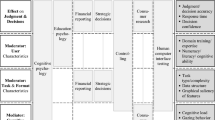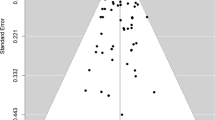Abstract
There is no lack of studies dealing with the consistency of evaluations performed by pairwise comparison in the decision-making literature. Mostly, these studies offer algorithms for reducing the inconsistency of evaluations and indices to measure the evaluation’s consistency degree. The focus on these two research fronts does not cover all the gaps associated with the inconsistent evaluation problem. The existing algorithms are difficult to implement and do not preserve the original evaluations since the original evaluation matrix is replaced with a new matrix. Furthermore, the inconsistency of pairwise comparison has been associated with the specialist’s bounded rationality only at the theoretical-conceptual level. This research investigates the relationship between the lack of specialist knowledge and the inconsistency of evaluations, as well as introduces an approach that ensures the evaluation’s consistency by reducing the specialist’s cognitive stress when comparing a high number of alternatives. The results reveal that the specialist’s limited knowledge about the topic does not impact the degree of consistency of the evaluations as expected. The evaluation’s consistency degree is 59% lower when the specialist does have no knowledge about the decision topic but has theoretical knowledge and experience in evaluating alternatives by pairwise comparison. This is a remarkable contribution with a high degree of universality and applicability because instructing decision-makers on the inconsistency problem is a cheaper, easier way to increase the evaluation’s consistency degree without altering the original information. Furthermore, the introduced approach reduces the number of evaluations and evaluation time by 8.0 and 7.8 times, respectively.

Similar content being viewed by others
Data Availability
Silva, LML, Libório, MP (2022) A new Ease of Doing Business Index for G20 countries: a consensus-based approach to weighting individual indicators. Mendeley Data, V2, doi: https://doi.org/10.17632/kwss6jyfxk.2.
Notes
Koczkodaj’s [31] Consistency Measure is calculated from a given element of the matrix and not on the characteristics of the global matrix as an eigenvalue. Salo and Hämäläinen’s [50] Consistency Measure is invariant to the scale and is calculated after transforming inconsistent responses into a non-empty set of viable priorities.
References
Amenta, P., Lucadamo, A., Marcarelli, G.: On the transitivity and consistency approximated thresholds of some consistency indices for pairwise comparison matrices. Inf. Sci. 507, 274–287 (2020)
Bampatsou, C., Halkos, G., Astara, O.H.: Composite indicators in evaluating tourism performance and seasonality. Oper. Res. Int. J., 1–24 (2020)
Becker, W., Saisana, M., Paruolo, P., Vandecasteele, I.: Weights and importance in composite indicators: closing the gap. Ecol. Ind. 80, 12–22 (2017)
Benítez, J., Delgado-Galván, X., Izquierdo, J., Pérez-García, R.: Achieving matrix consistency in AHP through linearization. Appl. Math. Model. 35(9), 4449–4457 (2011)
Benítez, J., Delgado-Galván, X., Izquierdo, J., Pérez-García, R.: Improving consistency in AHP decision-making processes. Appl. Math. Comput. 219(5), 2432–2441 (2012)
Bernardes, P., Ekel, P.I., Rezende, S.F.L., Pereira Júnior, J.G., dos Santos, A.C.G., da Costa, M.A.R., Libório, M.P.: Cost of doing business index in Latin America. Qual. Quant. 56(4), 2233–2252 (2022)
Boggia, A., Fagioli, F.F., Paolotti, L., Ruiz, F., Cabello, J.M., Rocchi, L.: Using accounting dataset for agricultural sustainability assessment through a multi-criteria approach: an Italian case study. Int. Trans. Oper. Res. (2022)
Bortot, S., Brunelli, M., Fedrizzi, M., Pereira, R.M.: A novel perspective on the inconsistency indices of reciprocal relations and pairwise comparison matrices. Fuzzy Sets Syst. (2022)
Bozóki, S., Fülöp, J., Poesz, A.: On reducing inconsistency of pairwise comparison matrices below an acceptance threshold. Cent. Eur. J. Oper. Res. 23(4), 849–866 (2015)
Bustince, H., Bedregal, B., Campión, M.J., Silva, D.I., Fernandez, J., Induráin, E., Santiago, R.H.: Aggregation of individual rankings through fusion functions: criticism and optimality analysis. IEEE Trans. Fuzzy Syst. 30(3), 638–648 (2020)
Camanho, A.S., Stumbriene, D., Barbosa, F., Jakaitiene, A.: The assessment of performance trends and convergence in education and training systems of European countries. Eur. J. Oper. Res. (2022)
Chen, X., Zhang, H., Dong, Y.: The fusion process with heterogeneous preference structures in group decision making: a survey. Inform. Fusion 24, 72–83 (2015)
Cherchye, L., Moesen, W., Rogge, N., Van Puyenbroeck, T., Saisana, M., Saltelli, A., Tarantola, S.: Creating composite indicators with DEA and robustness analysis: the case of the technology achievement index. J. Oper. Res. Soc. 59(2), 239–251 (2008)
Chiclana, F., Herrera, F., Herrera-Viedma, E.: Integrating three representation models in fuzzy multipurpose decision making based on fuzzy preference relations. Fuzzy Sets Syst. 97(1), 33–48 (1998)
Chiclana, F., Herrera, F., Herrera-Viedma, E.: Integrating multiplicative preference relations in a multipurpose decision-making model based on fuzzy preference relations. Fuzzy Sets Syst. 122(2), 277–291 (2001)
Corcoran, A., Gillanders, R.: Foreign direct investment and the ease of doing business. Rev. world Econ. 151, 103–126 (2015)
Crawford, G., Williams, C.: A note on the analysis of subjective judgment matrices. J. Math. Psychol. 29(4), 387–405 (1985)
Dialga, I., Giang, T.H., L: Highlighting methodological limitations in the steps of composite indicators construction. Soc. Indic. Res. 131, 441–465 (2017)
Djankov, S.: The doing business project: how it started: correspondence. J. Econ. Perspect. 30(1), 247–248 (2016)
Ekel, P., Pedrycz, W., Pereira, J., Jr.: Multicriteria Decision-Making Under Conditions of Uncertainty: A Fuzzy set Perspective. John Wiley & Sons, Hoboken (2019)
Ekel, P., Bernardes, P., Vale, G.M.V., Libório, M.P.: South American business environment cost index: Reforms for Brazil. Int. J. Bus. Environ. 13(2), 212–233 (2022a)
Ekel, P., Bernardes, P., Laudares, S., Libório, M.P.: Evidence of the negative relationship between transaction costs and economic performance in G7 + BRICS countries. Technol. Audit Prod. Reserves. 5(67), 37–42 (2022b)
El Gibari, S., Gómez, T., Ruiz, F.: Building composite indicators using multicriteria methods: a review. J. Bus. Econ. 89(1), 1–24 (2019)
Ergu, D., Kou, G., Peng, Y., Shi, Y.: A simple method to improve the consistency ratio of the pair-wise comparison matrix in ANP. Eur. J. Oper. Res. 213(1), 246–259 (2011)
Figueiredo, L.R., Frej, E.A., Soares, G.L., Ekel, P.Y.: Group decision-based construction of scenarios for multicriteria analysis in conditions of uncertainty on the basis of quantitative and qualitative information. Group Decis. Negot. 30(3), 665–696 (2021)
Fusco, E.: Enhancing non-compensatory composite indicators: a directional proposal. Eur. J. Oper. Res. 242(2), 620–630 (2015a)
Fusco, E.: Potential improvements approach in composite indicators construction: the multi-directional benefit of the doubt model. Socio-Economic Plann. Sci. 85, 101447 (2023)
Greco, S., Ishizaka, A., Tasiou, M., Torrisi, G.: On the methodological framework of composite indices: a review of the issues of weighting, aggregation, and robustness. Soc. Indic. Res. 141(1), 61–94 (2019)
Herrera-Viedma, E., Herrera, F., Chiclana, F., Luque, M.: Some issues on consistency of fuzzy preference relations. Eur. J. Oper. Res. 154(1), 98–109 (2004)
Ishizaka, A., Lusti, M.: An expert module to improve the consistency of AHP matrices. Int. Trans. Oper. Res. 11(1), 97–105 (2004)
Koczkodaj, W.W.: A new definition of consistency of pairwise comparisons. Math. Comput. Model. 18(7), 79–84 (1993)
Kuc-Czarnecka, M., Piano, S.L., Saltelli, A.: Quantitative storytelling in the making of a composite indicator. Soc. Indic. Res. 149(3), 775–802 (2020)
Lamata, M.T., Peláez, J.I.: A method for improving the consistency of judgements. Int. J. Uncertain. Fuzziness Knowledge-Based Syst. 10(06), 677–686 (2002)
Lee, S.K., Yu, J.H.: Composite indicator development using utility function and fuzzy theory. J. Oper. Res. Soc. 64(8), 1279–1290 (2013)
Li, G., Kou, G., Peng, Y.: A group decision making model for integrating heterogeneous information. IEEE Trans. Syst. Man Cybern.: Syst. 48(6), 982–992 (2016)
Libório, M.P., da Silva, L.M.L., Ekel, P.I., Figueiredo, L.R., Bernardes, P.: Consensus-based sub-indicator weighting approach: constructing composite indicators compatible with expert opinion. Soc. Indic. Res. 164, 1073–1099 (2022a)
Libório, M.P., Ekel, P.Y., Martinuci, O.D.S., Figueiredo, L.R., Hadad, R.M., Lyrio, R.D.M., Bernardes, P.: Fuzzy set based intra-urban inequality indicator. Qual. Quant. 56(2), 667–687 (2022b)
Libório, M.P., de Abreu, J.F., Ekel, P.I., Machado, A.M.C.: Effect of sub-indicator weighting schemes on the spatial dependence of multidimensional phenomena. J. Geogr. Syst. 25(2), 185–211 (2023)
Munda, G., Nardo, M.: Constructing Consistent Composite Indicators: The Issue of Weights. Institute for the Protection and Security of the Citizen, Italy (2005)
Pearson, K.: On lines and planes of closest fit to systems of points in space. Lond. Edinb. Dublin philosophical magazine J. Sci. 2(11), 559–572 (1901)
Pedrycz, W., Ekel, P., Parreiras, R.: Fuzzy Multi-Criteria Decision-Making: Models, Methods and Applications. John Wiley & Sons, Hoboken (2011)
Pinheiro-Alves, R., Zambujal-Oliveira, J.: The ease of doing Business Index as a tool for investment location decisions. Econ. Lett. 117(1), 66–70 (2012)
Proudlove, N.C., Goff, M., Walshe, K., Boaden, R.: The signal in the noise: robust detection of performance “outliers” in health services. J. Oper. Res. Soc. 70(7), 1102–1114 (2019)
Ramalho, F.D., Ekel, P.Y., Pedrycz, W., Júnior, J.G.P., Soares, G.L.: Multicriteria decision making under conditions of uncertainty in application to multiobjective allocation of resources. Inform. Fusion. 49, 249–261 (2019)
Ramalho, F.D., Silva, I.S., Ekel, P.Y., da Silva Martins, C.A.P., Bernardes, P., Libório, M.P.: Multimethod to prioritize projects evaluated in different formats. MethodsX. 8, 101371 (2021)
Rogge, N.: Composite indicators as generalized benefit-of-the-doubt weighted averages. Eur. J. Oper. Res. 267(1), 381–392 (2018)
Saaty, T.L.: A scaling method for priorities in hierarchical structures. J. Math. Psychol. 15(3), 234–281 (1977)
Saaty, T.: Multicriteria Decision Making: The Analytic Hierarchy Process. McGraw-Hill, New York (1980)
Saisana, M., Tarantola, S.: State-of-the-art Report on Current Methodologies and Practices for Composite indicator Development. European Commission, Joint Research Centre, Institute for the Protection and the Security of the Citizen, Technological and Economic Risk Management Unit, Ispra, Italy (2002)
Salo, A.A., Hämäläinen, R.P.: On the measurement of preferences in the analytic hierarchy process. J. Multi-Criteria Decis. Anal. 6(6), 309–319 (1997)
The World Bank Group:. DataBank: Doing Business 2020. Retrieved on May 5, 2022 (2020). From: https://databank.worldbank.org/source/doing-business
World Bank Group, World Bank Group to Discontinue Doing Business Report:. Retrieved on April 25, 2023 (2021). From: https://www.worldbank.org/en/news/statement/2021/09/16/world-bank-group-to-discontinue-doing-business-report
Wu, Z., Liao, H.: A consensus reaching process for large-scale group decision making with heterogeneous preference information. Int. J. Intell. Syst. 36(9), 4560–4591 (2021)
Xia, M., Xu, Z., Chen, J.: Algorithms for improving consistency or consensus of reciprocal [0, 1]-valued preference relations. Fuzzy Sets Syst. 216, 108–133 (2013)
Zamani, K., Omrani, H.: A complete information PCA-imprecise DEA approach for constructing composite indicator with interval data: an application for finding development degree of cities. Int. J. Oper. Res. 44(4), 522–549 (2022)
Zhang, Q., Chen, J.C., Chong, P.P.: Decision consolidation: criteria weight determination using multiple preference formats. Decis. Support Syst. 38(2), 247–258 (2004)
Zhang, B., Dong, Y., Herrera-Viedma, E.: Group decision making with heterogeneous preference structures: an automatic mechanism to support consensus reaching. Group Decis. Negot. 28(3), 585–617 (2019)
Zhou, M., Hu, M., Chen, Y.W., Cheng, B.Y., Wu, J., Herrera-Viedma, E.: Towards achieving consistent opinion fusion in group decision making with complete distributed preference relations. Knowl. Based Syst. 236, 107740 (2022)
Funding
This work was carried out with the support of the National Council for Scientific and Technological Development of Brazil (CNPq) - productivity grant 311922/2021-0 and Junior postdoctoral fellowship 151518/2022-0.
Author information
Authors and Affiliations
Corresponding author
Ethics declarations
Conflict of interest
The authors declare they have no financial interests.
Human and/or animals rights
No human participants and/or animals are involved in this research.
Additional information
Publisher’s Note
Springer Nature remains neutral with regard to jurisdictional claims in published maps and institutional affiliations.
Rights and permissions
Springer Nature or its licensor (e.g. a society or other partner) holds exclusive rights to this article under a publishing agreement with the author(s) or other rightsholder(s); author self-archiving of the accepted manuscript version of this article is solely governed by the terms of such publishing agreement and applicable law.
About this article
Cite this article
Libório, M.P., Ekel, P.I., Bernardes, P. et al. Specialists’ knowledge and cognitive stress in making pairwise comparisons. OPSEARCH 61, 51–70 (2024). https://doi.org/10.1007/s12597-023-00689-2
Accepted:
Published:
Issue Date:
DOI: https://doi.org/10.1007/s12597-023-00689-2
Keywords
- Pairwise comparison
- Matrix consistency
- Preference formats
- Transformation functions
- Composite indicator
- Group decision-making




